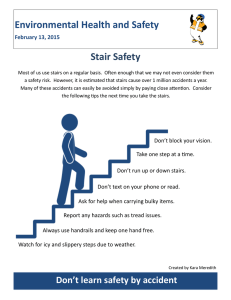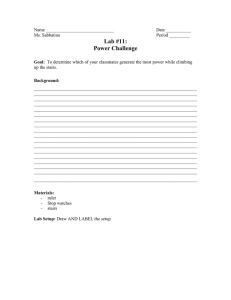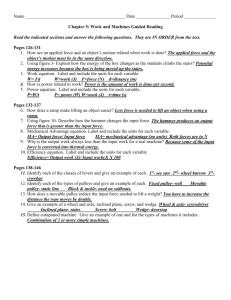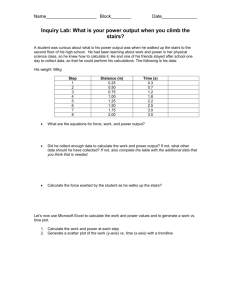Power Lab – Conceptual Physics
advertisement
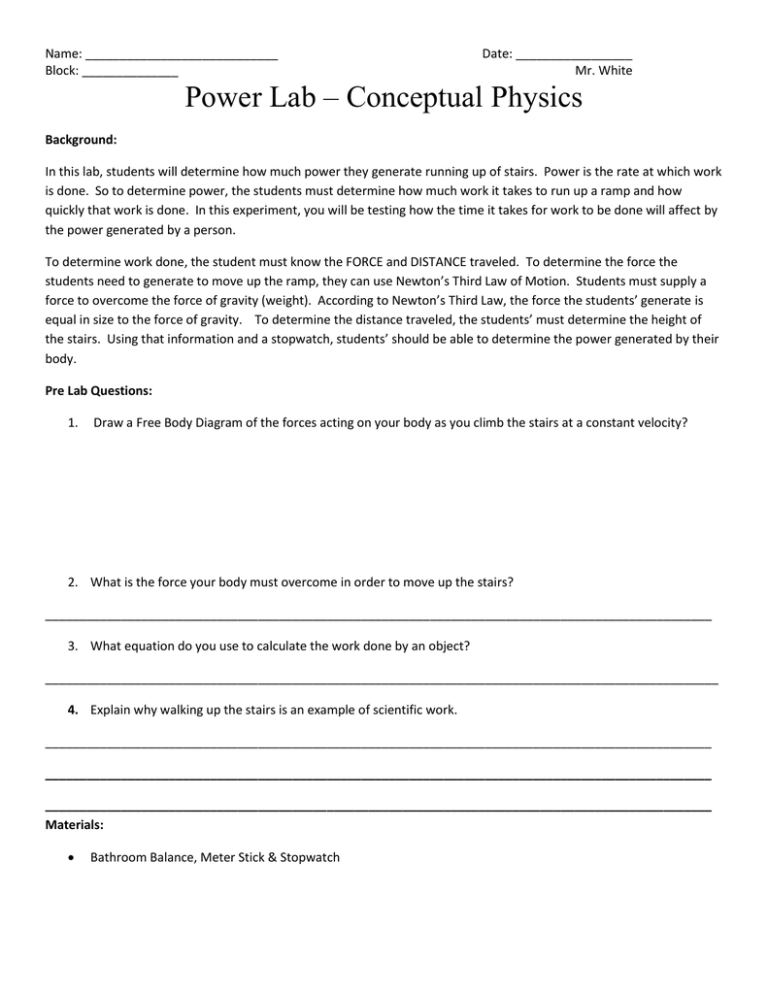
Name: ____________________________ Block: ______________ Date: _________________ Mr. White Power Lab – Conceptual Physics Background: In this lab, students will determine how much power they generate running up of stairs. Power is the rate at which work is done. So to determine power, the students must determine how much work it takes to run up a ramp and how quickly that work is done. In this experiment, you will be testing how the time it takes for work to be done will affect by the power generated by a person. To determine work done, the student must know the FORCE and DISTANCE traveled. To determine the force the students need to generate to move up the ramp, they can use Newton’s Third Law of Motion. Students must supply a force to overcome the force of gravity (weight). According to Newton’s Third Law, the force the students’ generate is equal in size to the force of gravity. To determine the distance traveled, the students’ must determine the height of the stairs. Using that information and a stopwatch, students’ should be able to determine the power generated by their body. Pre Lab Questions: 1. Draw a Free Body Diagram of the forces acting on your body as you climb the stairs at a constant velocity? 2. What is the force your body must overcome in order to move up the stairs? _________________________________________________________________________________________________ 3. What equation do you use to calculate the work done by an object? __________________________________________________________________________________________________ 4. Explain why walking up the stairs is an example of scientific work. _________________________________________________________________________________________________ _________________________________________________________________________________________________ _________________________________________________________________________________________________ Materials: Bathroom Balance, Meter Stick & Stopwatch Name: ____________________________ Block: ______________ Procedure: 1. Using the Bathroom Balance, measure your mass in Kilograms. Record this value in the Observations Table. 2. Using the meter stick, measure the height of one step in meters. Record this value in the Observation Table. 3. Count the number of stairs you will be moving up and record this value in the Observation Table. 4. Using the stop watch, time how long it takes you to WALK, JOG and RUN up the set of stairs. Record these times in the Observation Table. Analysis: Date: _________________ Mr. White Observation Table Mass (kg) Height of Step (m) Number of Steps Trial 1 Time (s) Walking Trial 2 Time (s) Jogging Trial 3 Time (s) Sprinting 1. Calculate your weight in Netwons. The is the FORCE you overcame to climb the stairs. 2. Using the height of one step and the number of steps in the staircase, determine the total height you climbed during the experiment (TOTAL DISTANCE). 3. Calculate theWORK you had to exert to climb the stairs. 4. Calculatethe POWER you generated in each trail. Record these values in the Analysis Data Table. 5. Create a bar graph below to compare the power generated in each trial. Make sure your graph has a title, is labeled and uses appropriate S.I.Units. ANALYSIS TABLE Force (N) Total Distance (m) Work (J) Power (W) -Walking Power (W) –Jogging Power (W) -Sprinting Conclusion: 1. What is the Independent Variable of this experiment? __________________________________ 2. What is the Dependent Variable of this experiment? ___________________________________ 3. What are two things you kept constant in this experiment? ____________________________________________________________________________________ 4. How did the time it takes to move up the ramp seem to affect the amount of power you generated? ____________________________________________________________________________________ 5. How could YOU generate even more power going up the ramp/stairs? _____________________________________________________________________________________
